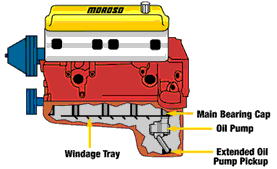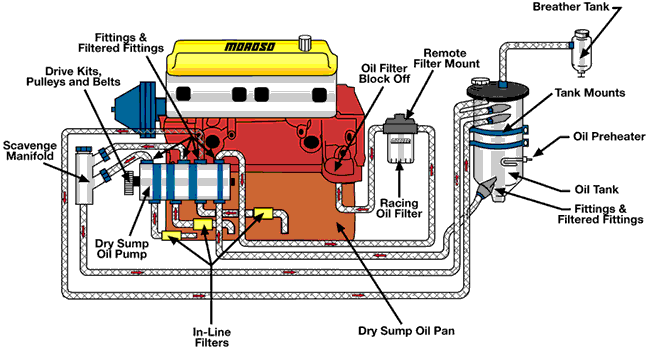The
use of a wet or dry sump oiling system is often determined by the level
of competition and the racer’s budget. A wet sump system is based on
the original equipment oiling system, and can be enhanced with certain
components to improve oil control and increase power. A dry sump system
is designed for the top levels of racing where maximum power and oil
control are absolutely essential.
Oil Pan Capacities
 Capacities
Capacities
listed for Moroso Wet Sump Oil Pans include the capacity of the pan
only, measured at or below the normal fill mark on a stock dipstick.
Additional oil must be added to compensate for filters, coolers, tanks,
etc.
Unlike
a wet sump system where oil is stored in the pan, a Dry Sump Oiling
system stores oil in a separate tank — leaving the pan essentially
"dry." An externally-mounted pump, generally with three or four stages,
is used to "scavenge" or remove oil from the pan, deliver it to the
storage tank, and send it back through the engine. In a typical setup,
all but one of the stages is used to scavenge oil from the pan. A
single pressure stage is normally used to return oil from the tank to
the engine.
 The primary advantage
The primary advantage
of a dry sump system is its ability to make more power. With very
little oil in the pan, the rotating assembly is not burdened with the
weight of excess oil (a phenomenon commonly referred to as "windage").
And because there is no internal pump, the windage tray or screen which
serves to isolate sump oil from the rotating assembly, is allowed to
run the full length of the pan. Keeping the rotating assembly free of
windage allows it to spin freely and make more
power. In addition, the extra crankcase vacuum created by the dry sump
pump helps to improve ring seal for additional power gain.
Other
advantages of a dry sump system include increased oil capacity, more
consistent oil pressure, the ability to easily add remote coolers, and
adjustable oil pressure. And because the pan doesn’t store oil, it can
be relatively shallow in depth to allow lower engine placement for
improved weight distribution and handling.
Moroso
manufactures a full range of Dry Sump Oiling System components, all of
which are engineered to be fully compatible with one another. This
allows the engine builder to select the best combination of equipment
and avoid the costly problems that often occur when "mixing and
matching" components from various manufacturers.
Note:
Oil pan rules vary from track to track. Check with your race track
and/or sanctioning body before selecting your Moroso Oil Pan.
Tech Tip courtesy of Moroso.













